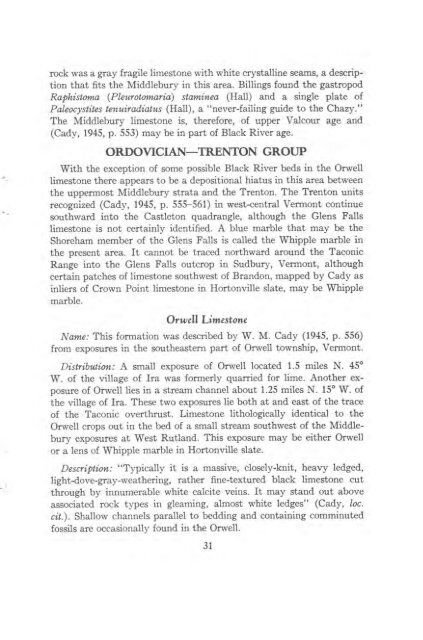STRATIGRAPHY AND STRUCTURE CASTLETON AREA VERMONT
STRATIGRAPHY AND STRUCTURE CASTLETON AREA VERMONT
STRATIGRAPHY AND STRUCTURE CASTLETON AREA VERMONT
Create successful ePaper yourself
Turn your PDF publications into a flip-book with our unique Google optimized e-Paper software.
ock was a gray fragile limestone with white crystalline seams, a description<br />
that fits the Middlebury in this area. Billings found the gastropod<br />
Raphistoma (Pleurotomaria) staminea (Hall) and a single plate of<br />
Paleocystites tenuiradiatus (Hall), a "never-failing guide to the Chazy."<br />
The Middlebury limestone is, therefore, of upper Valcour age and<br />
(Cady, 1945, p. 553) may be in part of Black River age.<br />
ORDOVICIAN—TRENTON GROUP<br />
With the exception of some possible Black River beds in the Orwell<br />
limestone there appears to be a depositional hiatus in this area between<br />
the uppermost Middlebury strata and the Trenton. The Trenton units<br />
recognized (Cady, 1945, p. 555-561) in west-central Vermont continue<br />
southward into the Castleton quadrangle, although the Glens Falls<br />
limestone is not certainly identified. A blue marble that may be the<br />
Shoreham member of the Glens Falls is called the Whipple marble in<br />
the present area. It cannot be traced northward around the Taconic<br />
Range into the Glens Falls outcrop in Sudbury, Vermont, although<br />
certain patches of limestone southwest of Brandon, mapped by Cady as<br />
inliers of Crown Point limestone in Hortonville slate, may be Whipple<br />
marble.<br />
Orwell Limestone<br />
Name: This formation was described by W. M. Cady (1945, p. 556)<br />
from exposures in the southeastern part of Orwell township, Vermont.<br />
Distribution: A small exposure of Orwell located 1.5 miles N. 450<br />
W. of the village of Ira was formerly quarried for lime. Another exposure<br />
of Orwell lies in a stream channel about 1.25 miles N. 15° W. of<br />
the village of Ira. These two exposures lie both at and east of the trace<br />
of the Taconic overthrust. Limestone lithologically identical to the<br />
Orwell crops out in the bed of a small stream southwest of the Middlebury<br />
exposures at West Rutland. This exposure may be either Orwell<br />
or a lens of Whipple marble in Hortonville slate.<br />
Description: "Typically it is a massive, closely-knit, heavy ledged,<br />
light-dove-gray-weathering, rather fine-textured black limestone cut<br />
through by innumerable white calcite veins. It may stand out above<br />
associated rock types in gleaming, almost white ledges" (Cady, bc.<br />
cit.). Shallow channels parallel to bedding and containing comminuted<br />
fossils are occasionally found in the Orwell.<br />
31













